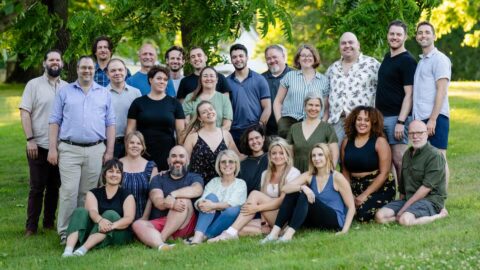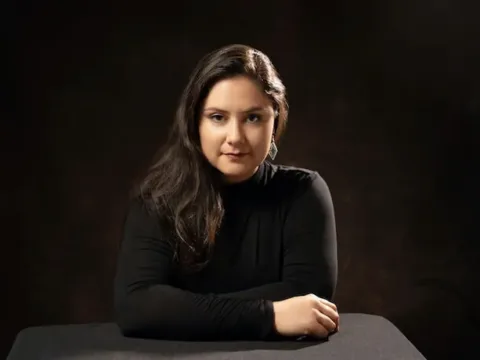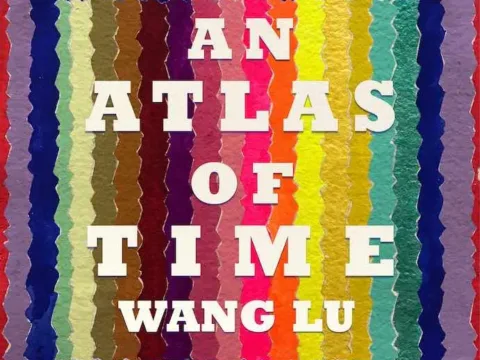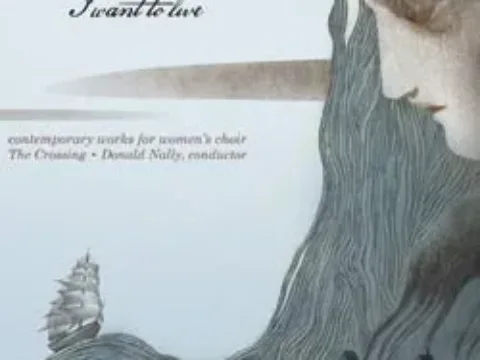Released on April 4 2025, At Which Point (New Focus Recordings) from The Crossing continues the choir’s dedication to commissioning and furthering the genre of choral music. Having commissioned nearly 170 works, often on social justice and environmental topics, this album brings together three works from Ayanna Woods, Wang Lu, and Tawnie Olson. By featuring pieces that examine artistic process and expression as well as experiences of contemporary society, The Crossing have created a cohesive album that must be listened to with the utmost care and attention.
The album opens with Infinite Body by Ayanna Woods, a multi-movement work that examines the ways we bend and shape ourselves in a capitalist society. Through Woods’s text, the work displays a wide array of textures and colors, highlighting the complexity of the choir as a vehicle. The first movement, “Infinite Growth,” immediately arrests the listeners in its intricate beat patterns that create a shimmer atop expansive, lush chords.
Melismatic moments harken back to a modal, sacred style of writing in the midst of truly visionary choral setting and harmonization. Woods also shares her sense of humor in “One Body,”a rhythmic commentary on machinery, systemization, and “order.” The third movement, “Do Be Do,” steps back and allows the listener to reflect on the very real question: “Do you worry about falling short?” The eloquent chords and textures elevates that simple question into a rhetorical reflection, highlighting the underlying fears that intermix with outward facing productivity and success. The blend of old and new returns in the final movement, “Golden Hour,” in which solo heterophonic moments break through soundclouds of inscrutable fog, gorgeous moments of lush density and dissonance.
The title piece, At Which Point, by Wang Lu, features a wide variety of text setting for two surrealist poems by Forrest Gander. The first movement, “Prologue,” is a microtonal adventure of polyphonic swoops and tone clusters that artfully clash with one another, preparing for the second and third movements, “Beckoned” and “The Sounding,” each a setting of a Gander poem of the same name. “Beckoned” describes a wild scene of swarming stinging bees and a cab ride from a flute-playing driver. Lu sets this in a through-composed narrative style, using text painting generously in her interpretation and portrayal of the story. “The Sounding” begins with a stark opening of open fifths and large gaps between the basses and sopranos, creating a cavernous atmosphere for the soloists to glide in and around with dramatic glissandi, almost as if they were birds flying around in the cavern.
Towards the end of the movement, Lu amplifies the sense of fleetingness and spaciousness from the text by adding mouth harps into the texture. The mouth harps create an otherworldly panning through the choir that transport the listener further beyond the initial cavern Lu initially painted. Conductor Donald Nally and The Crossing show clear mastery of their craft in this movement as they balance extreme ranges, textures, and complex writing with exceptional ease.

The final premiere on the album is Tawnie Olson’s Beloved of the Sky. Olson’s work, commissioned by the Barlow Endowment, features five journal entries by Canadian author and artist Emily Carr. In these entries, Carr describes her creative process, one that focuses on often overlooked natural and Indigenous subjects and landscapes. Olson then amplifies these seemingly simple phrases in such a way that word painting falls short of accurate description. In “I went down deep” and “I woke with this idea…,” Olson artfully uses textual and melodic repetition, layering more voices and notes into her phrases and turning a simple unison into a complex harmony over time.
The Crossing exhibits immaculate intonation and blending in the unison moments of the piece, in particular the opening of the third movement, “Oh, that stodgy, lumpy feeling,”that features homophony and intricately subtle counterpoint. Olson’s use of sharp dynamic contrast and homophonic punctuation shines “The subject that means little,”which brings to life the crux of the text’s focus on the subject less examined. The final movement, “I made a small sketch,” beautifully rounds out the cycle and closes the album in its contemplative calls, responses, and lush harmonizations.
The Crossing’s At Which Point is definitely on the “do not miss” list and worthy of a GRAMMY nomination this coming year. Nally’s exceptional conducting and the composers’ beautiful works make the most delicate and strong moments live seamlessly in the program presented on this album.
I CARE IF YOU LISTEN is an editorially-independent program of the American Composers Forum, and is made possible thanks to generous donor and institutional support. Opinions expressed are solely those of the author and may not represent the views of ICIYL or ACF.
You can support the work of ICIYL with a tax-deductible gift to ACF. For more on ACF, visit composersforum.org.




